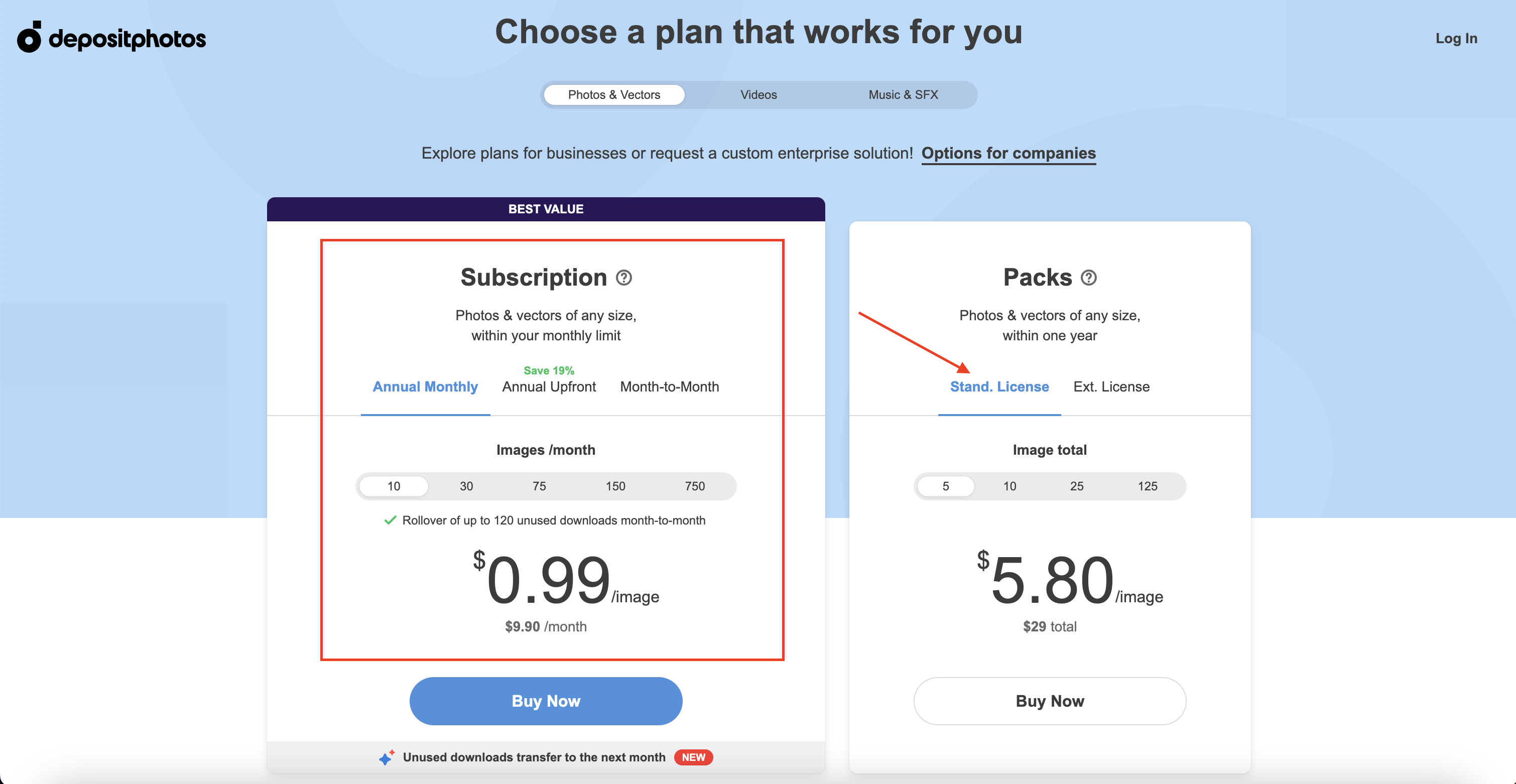Standard License Vs. Extended License for Images. What to choose?
To use images for projects—personal or commercial—you need to possess the rights to do so. One way to go about this is to create an image from scratch yourself. However, if you are not keen on photography or illustration or simply don’t want to spend time crafting a visual, an already-created image might be your best solution. The only thing is, you need permission from the author to use their work.
With stock platforms like Depositphotos, getting licensed content is easy. You enter keywords into the search bar, pick a file you like, and download it immediately—the image is yours!
If characteristics like “Standard Licence”, “Editorial Use Only”, or “Attributed Free License Agreement” seem confusing, let us guide you through all the types of image licenses so you can be sure to make the right choice.
What types of licenses can you spot on Depositphotos?
Most photos, vectors, and illustrations in the Depositphotos library are available under the Standard License. This type of license agreement covers the most popular stock image use cases. But not all of them.
Some rules apply to content of all types of licenses. For example, you can use images for work with third parties (note that the license doesn’t go to your partner) and download them without watermarks. Regardless of your license type, stock images can’t be resold.
Here are the differences between images licenses on Depositphotos:
Standard License

Content type: photos, vectors, illustrations, and images you generate with our AI
Plans: Subscriptions, Packs
This license type lets you use purchased images for commercial, educational, artistic, and personal projects. The most popular use cases include social media content, website and app design, packaging, blogs, booklets, and other digital and print materials. You can also apply Standard License stock content while creating logos, but consider that you can’t make this logo a part of a trademark or service mark in the future.
Standard License images have certain usage limitations: Print materials featuring them are limited to less than 500,000 copies; you can’t resell items designed with these images if stock images give designed items major value.
More about product packaging design—Key Strategies for Transformative Packaging Design.
Extended License

Content type: photos, vectors, and illustrations
Plans: Packs
To use Extended License images, you need to purchase Packs that include this type of license; Packs like these are more expensive than standard ones (example: $29 and $69 for a Pack of 5 images).
The Extended License gives you all the perks of Standard Licenses but doesn’t have limitations for print runs—you can create books, magazines, newspapers, and marketing materials with over 500,000 copies.
With an Extended License, you are allowed to design items for resale or free distribution, with images playing a pivotal role in their value—for example, posters, postcards, coloring books, T-shirts, or fabrics. As for digital products, you can craft screensavers and desktop wallpapers for resale or distribution.
Explore more on images for commercial needs—Types of Visuals Every eCommerce Brand Needs.
Free File License
(Standard License with attribution)
Content type: photos, vectors, illustrations
Plans: no plan is needed, only for registered users
If you receive weekly Free File updates from Depositphotos or visit our Free Files page regularly, you’ve probably noticed that we allow users to download some files for free. Moreover, the selection of free images is different from month to month.
If an image has a “Free” label on its preview, it means that the author has allowed us to offer their work for free for a short time. In turn, you can download and use such images in commercial and personal projects.
These days, the Free Files library on Depositphotos includes over 68,000 items and has handy navigation. The difference between a Standard License and Free File License (Attributed Free License Agreement) is that all Free Files can only be used with attribution. To credit a copyright owner, you must accompany an image with a copyright notice of the following format: “[nickname of the author] / depositphotos.com”.
Discover free files in our recent collection—Summer Color Trends 2024: Curated Image Collections, Palettes, and Mockups.
Editorial Use Only
(limited Standard License)
Content type: photos
Plans: all types, including Free Files usage
There are over 22 million images in our library that are marked as “Editorial”. This label means they can be downloaded under a limited Standard License, and you can only integrate them into your non-commercial materials. In particular, you are allowed to use editorial photos as a visual reference in blogs, news materials, or magazines, as well as publications on websites where the primary purpose of your content is to educate, inform, or entertain.
Why are editorials limited in usage? Editorial photos might include elements protected by copyright law or the international privacy policy. For example, they can feature celebrities or other people who have not signed a model release agreement. Other cases include featuring sports or public events, trademarked buildings, and private property visuals.
As with Free Files, you must credit the authors of editorial content. The format for a copyright notice remains the same: “[nickname of the author] / depositphotos.com”.
Compare Licenses
Transferring licenses to third parties. What should you know?
As stated above, neither Extended nor Standard licenses allows you to transfer and sublicense purchased images—they are just for individual use. By purchasing any of our plans for individuals, you can download pictures for projects created for third parties, but image rights are not automatically transferred to your clients or company.
What should you do if you work for a firm that wants to own images for design use? On its behalf, purchase a plan for businesses (click on “Options for Companies” on our pricing page to see available plans).
For businesses, we offer Ready-to-Use and Customizable solutions, all of which allow companies to have subaccounts. They enable teams to download images within a Subscription or through Packs and enjoy Standard License and Extended License perks.
One more option you have as a business is to request custom solutions with flexible pricing, high indemnification, unwatermarked comps, and third-party rights transfers. To see what we can offer you, leave a note for our manager—the contact form is available on the pricing and Enterprise page.
Go to Enterprise Solutions
Have questions? Contact our Support Team
By becoming a Depositphotos client, you get access to 24/7 client support, so don’t hesitate to ask them about tricky stock image use cases. You can contact our managers via LiveChat from any website page or visit sections that may already include questions you were about to ask: Frequently Asked Questions and All Documents.
Useful articles about effective image usage:
7 Common Misconceptions about AI-generated Images
Dos and Don’ts for Creatives Working with Text-to-Image AI
Symmetrical and Asymmetrical Balance: How to Harmonize a Design
Color Psychology Explained: How Hues Can Evoke Emotions and Influence Decisions













